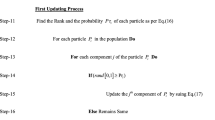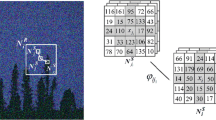Abstract
Image segmentation is a very important low-level vision task. It is the perceptual grouping of pixels based on some similarity criteria. In this article, we have applied spatial fuzzy genetic algorithm (SFGA) for the unsupervised segmentation of color images. The SFGA adds diversity to the search process to find the global optima. The performance of SFGA is influenced by two factors: first, K number of clusters—should be known in advance; second, the initialization of the cluster centers. To overcome these issues, a progressive technique based on self-organizing map is presented to find out the optimal K number of clusters automatically. To handle the initialization problem, peaks are identified using the image color histograms. The genetic algorithm with fuzzy behavior maximizes the fuzzy separation and minimizes the global compactness among the segments. The segmentation is performed on wavelet transform image which not only reduces the dimensionality and computational cost but also makes more compact segments. A novel pruning technique is proposed to handle the problem of over-segmentation. The results show that the proposed technique outperforms state-of-the-art methods.
Similar content being viewed by others
References
Lucchese, L., Mitra, S.K.: Color image segmentation: a state of the art survey. In: Proceedings of the Indian National Science Academy on Image Processing, Vision Pattern Recognition, vol. 67, no. 2, pp. 207–221 (2001)
Loo, P.K., Tan, C.L.: Adaptive region growing color segmentation for text using irregular pyramid. In: International Workshop on Document Analysis Systems, vol. 3163, pp. 264–275 (2004)
Kass M., Witkin A., Terzopoulos D.: Snakes: active contour models. Int. J. Comput. Vis. 1(4), 321–331 (1988)
Cohen L.: On active contour models and balloons. CVGIP Image Underst. 53(2), 211–218 (1991)
Xu C., Prince J.: Snakes, shapes, and gradient vector flow. In: IEEE Trans. Image Process. 7(3), 359–369 (1998)
Mortensen E., Barrett W.: Interactive segmentation with intelligent scissors. Graph. Models Image Process. 60(5), 349–384 (1998)
Besag J.: On the statistical analysis of dirty pictures. J. R. Stat. Soc. B 48, 259–302 (1986)
Boy Kov, Y., Jolly, M.: Interactive graph cuts for optimal boundary region segmentation of objects in N-D images. In: IEEE International Conference on Computer Vision, vol. 1, pp. 105–112 (2001)
Kolmogorov, V., Zabih, R.: What energy functions can be minimized via graph cuts ? In: IEEE Trans. Pattern Anal. Mach. Intell. 26(2), 147–159 (2004)
Rother C., Kolmogorov V., Blake A.: Grabcut interactive foreground extraction using iterated graphcuts. ACM Trans. Graph. 23(3), 309–314 (2004)
Li Y., Sun J., Tang C.K., Shum H.Y.: Lazy snapping. ACM Trans. Graph. 23(3), 303–308 (2004)
Beucher S., Meyer F.: The morphological approach to segmentation: the watershed transformation. Math. Morphol. Image Process. 34, 433–481 (1993)
Vincent L., Soille P.: Watersheds in digital spaces: an efficient algorithm based on immersion simulations. In: IEEE Trans. Pattern Anal. Mach. Intell. 13(6), 583–598 (1999)
Duda R., Hart P., Stork D.: Pattern Classification, 2nd edn. Wiley, Hoboken (2001)
Ahmed M.N., Yamany S.M., Farag A.A., Mohamed N., Moriarty T.: A modified fuzzy C-means algorithm for bias field estimation and segmentation of mri data. In: IEEE Trans. Med. Imaging 21(3), 193–199 (2002)
Chuang K.S, Tzeng H.L., Chen S., Chen T.J.: Fuzzy C-means clustering with spatial information for image segmentation. Comput. Med. Imaging Graph. 30, 9–15 (2006)
Choi H., Baraniuk R.G.: Multiscale image segmentation using wavelet-domain hidden markov models. In: IEEE Trans. Image. Process. 10(9), 1309–1321 (2001)
Chang T., Jay Kuo C.J.: Texture analysis and classification with tree-structured wavelet transform. In: IEEE Trans. Image. Process. 2(4), 429–441 (1993)
Kohonen T.: Self-Organising Maps, Springer Series in Information Sciences. 3rd edn, vol. 30. Heidelberg, Berlin (2001)
Pena J.M., Lozano J.A., Larranaga P.: An empirical comparison of four initialization methods for the k-means algorithm. Pattern Recognit. Lett. 20, 1027–1040 (1999)
Tan K.S., MatIsa N.A.: Color image segmentation using histogram thresholding fuzzy C-means hybrid approach. Pattern Recognit. 44, 1–15 (2011)
Ilea D.E., Whelan P.F.: Ctex—an adaptive unsupervised segmentation algorithm based on colour-texture coherence. In: IEEE Trans. Image Process. 17(10), 1926–1939 (2008)
Mukhopadhyay A., Maulik U., Bandyopadhyay S.: Multiobjective genetic algorithm-based fuzzy clustering of categorical attributes. In: IEEE Trans. Evolut. Comput. 13(5), 992–1005 (2009)
Tsekouras G.E., Papageorgiou D., Kotsiantis S., Kalloniatis C., Pintelas P.: Fuzzy clustering of categorical attributes and its use in analyzing cultural data. Int. J. Comput. Intell. 1(3), 147–151 (2004)
Martin, D., Fowlkes, C., Tal, D., Malik, J.: A database of human segmented natural images and its application to evaluating segmentation algorithms and measuring ecological statistics. In: Proceedings of the IEEE International Conference Computer Vision, vol. 2, pp. 416–423 (2001)
Yang A.Y., Wright J., Sastry S.S., Ma Y.: Unsupervised segmentation of natural images via lossy data compression. Comput. Vis. Image Underst. 110(2), 212–225 (2008)
Nock R., Nielsen F.: Statistical region merging. In: IEEE Trans. Pattern Anal. Mach. Intell. 26(11), 1452–1458 (2004)
Vazquez E., Baldrich R., Weijer J., Vanrell M.: Describing reflectances for colour segmentation robust to shadows, highlights and textures. J. Latex Class Files 6(1), 1–15 (2007)
Martin, D., Fowlkes, C., Tal, D., Malik, J.: A database of human segmented natural images and its application to evaluating segmentation algorithms and measuring ecological statistics. In: Proceedings of the IEEE International Conference Computer Vision, vol. 2, pp. 416–423 (2001)
Freixenet, J., Munoz, X., Raba, D., Marti, J., Cufi, X.: Yet another survey on image segmentation: Region and boundary information integration. In: Proceedings of the European Conference Computer Vision, pp. 408–422 (2002)
Unnikrishnan R., Pantofaru C., Hebert M.: Toward objective evaluation of image segmentation algorithms. In: IEEE Trans. Pattern Anal. Mach. Intell. 29(6), 929–944 (2007)
Meila, M.: Comparing clusterings-an axiomatic view. In: Proceedings of the International Conference Machine Learning, pp. 577–584 (2005)
Author information
Authors and Affiliations
Corresponding author
Rights and permissions
About this article
Cite this article
Khan, A., Ullah, J., Jaffar, M.A. et al. Color image segmentation: a novel spatial fuzzy genetic algorithm. SIViP 8, 1233–1243 (2014). https://doi.org/10.1007/s11760-012-0347-8
Received:
Revised:
Accepted:
Published:
Issue Date:
DOI: https://doi.org/10.1007/s11760-012-0347-8




